Near-Field Magnetic Shielding in the Frequency Range from 20 Hz to 100 MHz
Abstract
1. Introduction
2. Materials and Methods
- -
- the equation has been experimentally verified on certain frequency domains;
- -
- it is verified within the phenomenology of the Fabry–Perot interferometer in the framework of electromagnetic optics.
- Absorption loss term:
- Reflection loss term (for magnetic field):
- Multiple reflections term (for magnetic field):
- -
- antenna misalignment, including their plan-parallelism, which is checked every time according to the above-mentioned procedure;
- -
- ambient magnetic noise (only 50 Hz and its harmonics are detectable), which is eliminated by avoiding 50 Hz, 100 Hz, 150 Hz, 200 Hz, and 300 Hz frequencies, as can be seen in the article;
- -
- current fluctuations in the transmitting antenna, which unfortunately can only be reduced by using high-performance amplifiers or complex electronic systems.
3. Results
3.1. The Dynamic Range of the Shielded Enclosure
3.2. Material Testing in the 1 kHz–100 MHz Frequency Range
3.2.1. Copper
3.2.2. Conductivity Dependence of SEdB in the Range 100 kHz–80 MHz
3.2.3. The Dependence of SEdB on the Shield Thickness in the Range 100 kHz–100 MHz
3.3. Measurements in the Range 20 Hz–300 kHz
4. Discussion
- -
- Electrical steel, like any material with magnetic properties, cannot be analytically calculated because the dependence of magnetic permeability on frequency is not known;
- -
- These materials are of great importance in shielding low-frequency magnetic fields, unlike conductive ones with no magnetic properties, as can be seen in the figure (approx. 20 dB);
- -
- The combination between Cu/Al and magnetic materials is often used in shielding practice, this structure showing superior characteristics compared to the components taken separately, as can be seen from the presented diagrams.
5. Conclusions
- the use of much smaller material sizes for measurements than those used until now (~0.027 m2);
- expanded measurement range (between 20 Hz and 100 MHz);
- using a shielded enclosure with a declared dynamic range of 70–105 dB in the specified measurement range.
Author Contributions
Funding
Institutional Review Board Statement
Informed Consent Statement
Data Availability Statement
Conflicts of Interest
References
- Chung, D.D.L. Materials for electromagnetic interference shielding. Mater. Chem. Phys. 2020, 255, 123587. [Google Scholar] [CrossRef]
- Kittur, J.; Desai, B.; Chaudhari, R.; Loharkar, P.K. A comparative study of EMI shielding effectiveness of metals, metal coatings and carbon-based materials. IOP Conf. Ser. Mater. Sci. Eng. 2020, 810, 012019. [Google Scholar] [CrossRef]
- Zimmer, S.; Helwig, M.; Winkler, A.; Modler, N. Modeling Electrical Conductivity of Metal Meshes for Predicting Shielding Effectiveness in Magnetic Fields of Wireless Power Transfer Systems. Electronics 2022, 11, 2156. [Google Scholar] [CrossRef]
- Bachir, G.; Abdechafik, H.; Mecheri, K. Comparison Electromagnetic Shielding Effectiveness Between Single Layer and Multilayer Shields. In Proceedings of the 51st International Universities Power Engineering Conference (UPEC), Coimbra, Portugal, 6–9 September 2016. [Google Scholar] [CrossRef]
- Yang, Q.; Gao, Y.; Li, T.; Ma, L.; Qi, Q.; Yang, T.; Meng, F. Advances in carbon fiber-based electromagnetic shielding materials: Composition, structure, and application. Carbon 2024, 226, 119203. [Google Scholar] [CrossRef]
- Li, J.; Li, J.; Li, T.; Xu, Z.; Chen, Y.; Zhang, L.; Qi, Q.; Liang, B.; Meng, F. Flexible and excellent electromagnetic interference shielding film with porous alternating PVA-derived carbon and graphene layers. iScience 2023, 26, 107975. [Google Scholar] [CrossRef]
- Kumar, R.; Sahoo, S.; Joanni, E.; Singh, R.K.; Tan, W.K.; Kar, K.K.; Matsuda, A. Recent progress on carbon-based composite materials for microwave electromagnetic interference shielding. Carbon 2021, 177, 304–331. [Google Scholar] [CrossRef]
- Li, C.; Zhou, C.; Lv, J.; Liang, B.; Li, R.; Liu, Y.; Hu, J.; Zeng, K.; Yang, G. Bio-molecule adenine building block effectively enhances electromagnetic interference shielding performance of polyimide-derived carbon foam. Carbon 2019, 149, 190–202. [Google Scholar] [CrossRef]
- Deng, W.; Zhi, D.; Li, J.; Li, T.; Liu, Q.; Li, J.; Zhu, J.; Meng, F. Electromagnetic oscillation induced graphene-based aerogel microspheres with dual-chamber achieving high-performance broadband microwave absorption. Compos. B Eng. 2024, 271, 111149. [Google Scholar] [CrossRef]
- Crank, B.; Fricker, B.; Hubbard, A.; Hitawala, H.; Muna, F.I.; Okunlola, O.S.; Doherty, A.; Hulteen, A.; Powers, L.; Purtell, G.; et al. Electromagnetic Radiation Shielding Using Carbon Nanotube and Nanoparticle Composites. Appl. Sci. 2025, 15, 8696. [Google Scholar] [CrossRef]
- Zhao, Q.; Zhang, K.; Zhu, S.; Xu, H.; Cao, D.; Zhao, L.; Zhang, R.; Yin, W. Review on the Electrical Resistance/Conductivity of Carbon Fiber Reinforced Polymer. Appl. Sci. 2019, 9, 2390. [Google Scholar] [CrossRef]
- Voronovich, S.; Paddubskaya, A.; Batrakov, K.; Kuzhir, P.; Maksimenko, S.; Kaplas, T.; Svirko, Y. Electromagnetic Properties of Graphene-like Films in Ka-Band. Appl. Sci. 2014, 4, 255–264. [Google Scholar] [CrossRef]
- Kumari, P.; Tripathi, P.; Singh, S.P.; Kumar, D. Electromagnetic shielding using ceramic materials. In Materials for Potential EMI Shielding Applications, 1st ed.; Joseph, K., Wilson, R., George, G., Eds.; Elsevier: Oxford, UK, 2020; Volume 1, pp. 315–331. [Google Scholar] [CrossRef]
- Kornack, T.W.; Smullin, S.J.; Lee, S.-K.; Romalis, M.V. A low-noise ferrite magnetic shield. Appl. Phys. Lett. 2007, 90, 223501. [Google Scholar] [CrossRef]
- Naito, Y.; Yin, J.; Mizumoto, T. Electromagnetic wave absorbing properties of carbon-rubber doped with ferrite. Electron. Commun. Jpn. (Part II Electron.) 1988, 71, 77–83. [Google Scholar] [CrossRef]
- Kim, D.I.; Takahashi, M.; Anzai, H.; Jun, S.Y. Electromagnetic wave absorber with wide-band frequency characteristics using exponentially tapered ferrite. IEEE Trans. Electromagn. Compat. 1996, 38, 173–177. [Google Scholar] [CrossRef]
- Vinnik, D.A.; Zhivulin, V.E.; Sherstyuk, D.P.; Starikov, A.Y.; Zezyulina, P.A.; Gudkova, S.A.; Zherebtsov, D.A.; Rozanov, K.N.; Trukhanov, S.V.; Astapovich, K.A.; et al. Electromagnetic properties of zinc-nickel ferrites in the frequency range of 0.05–10 GHz. Mater. Today Chem. 2021, 20, 100460. [Google Scholar] [CrossRef]
- Thakur, N.; Sharma, I.; Thakur, P.; Batoo, K.M.; Shirsath, S.E.; Kumar, G. Optimized electromagnetic shielding properties using bismuth-doped barium hexaferrite nanoparticles. Polyhedron 2025, 268, 117384. [Google Scholar] [CrossRef]
- Kruželák, J.; Kvasničáková, A.; Hložeková, K.; Dosoudil, R.; Gořalík, M.; Hudec, I. Electromagnetic Interference Shielding and Physical-Mechanical Characteristics of Rubber Composites Filled with Manganese-Zinc Ferrite and Carbon Black. Polymers 2021, 13, 616. [Google Scholar] [CrossRef]
- Kruželák, J.; Kvasničáková, A.; Džuganová, M.; Hašková, L.; Dosoudil, R.; Hudec, I. Curing, Properties and EMI AbsorptionShielding of Rubber Composites Based on Ferrites and Carbon Fibres. Polymers 2023, 15, 857. [Google Scholar] [CrossRef]
- Wang, M.; Zhang, Y.; Dong, C.; Chen, G.; Guan, H. Preparation and electromagnetic shielding effectiveness of cobalt ferrite nanoparticles/carbon nanotubes composites. Nanomater. Nanotechnol. 2019, 9, 1847980419837821. [Google Scholar] [CrossRef]
- Li, W.; Le, C.; Qiao, L.; Zhen, J.; Ying, Y.; Yu, L.; Jiang, L.; Che, S. Electromagnetic Interference Shielding Effectiveness and Microwave Absorption of Ferrite-polymer Composite Using Ni0.32Cu0.08Zn0.6Fe2O4 Ferrite. In Proceedings of the Progress in Electromagnetic Research Symposium (PIERS), Shanghai, China, 8–11 August 2016. [Google Scholar] [CrossRef]
- Petrović, D.; Lazić, M.; Aleksić, O.; Nikolić, M.V.; Ibrahimović, V.; Pajnić, M. Mn-Zn ferrite line EMI suppressor for power switching noise in the impulse/high current bias regime. Turk. J. Electr. Eng. Comp. Sci. 2018, 26, 2426–2436. [Google Scholar] [CrossRef]
- Wyatt, B.C.; Thakur, A.; Anasori, B. MXenes for atomistic design of 2D nanoceramics. Bull. Am. Ceram. Soc. 2022, 101, 24–28. [Google Scholar]
- Mannafi, A.S.M.; Habib, K.; Ali, S.A.; Younas, M.; Bakthavatchalam, B.; Saha, B.B. MXene-based materials for electromagnetic interference shielding: Fundamentals, mechanisms, and emerging applications. Results Eng. 2025, 27, 107027. [Google Scholar] [CrossRef]
- Ma, H.; Li, C.; Yang, Y.; Fan, Z. 3D Porous MXene Films for Advanced Electromagnetic Interference Shielding and Capacitive Storage. Crystals 2022, 12, 780. [Google Scholar] [CrossRef]
- Xia, X.; Xiao, Q. Electromagnetic Interference Shielding of 2D Transition Metal Carbide (MXene)/Metal Ion Composites. Nanomaterials 2021, 11, 2929. [Google Scholar] [CrossRef]
- Li, Z.; Wang, Z.; Lu, W.; Hou, B. Theoretical Study of Electromagnetic Interference Shielding of 2D MXenes Films. Metals 2018, 8, 652. [Google Scholar] [CrossRef]
- Han, X.; Lee, J.J.; Kyoung, J.S.; Woo, Y.S. The Effect of Microstructural Changes Produced by Heat Treatment on the Electromagnetic Interference Shielding Properties of Ti-Based MXenes. Nanomaterials 2025, 15, 676. [Google Scholar] [CrossRef]
- Gan, Y.; Xiong, Y. Review of MXene synthesis and applications in electromagnetic shielding. RSC Adv. 2025, 15, 9555. [Google Scholar] [CrossRef]
- Allen-Perry, K.; Straka, W.; Keith, D.; Han, S.; Reynolds, L.; Gautam, B.; Autrey, D.E. Tuning the Magnetic Properties of Two-Dimensional MXenes by Chemical Etching. Materials 2021, 14, 694. [Google Scholar] [CrossRef]
- Shukla, V. The tunable electric and magnetic properties of 2D MXenes and their potential applications. Mater. Adv. 2020, 1, 3104. [Google Scholar] [CrossRef]
- Zhang, Y.; Shi, J.; Fu, Z.; Zheng, Q.; Wang, L.; Jiang, W. Engineering metal–organic frameworks for advanced ceramic composites. J. Am. Ceram. Soc. 2025, 105, e20509. [Google Scholar] [CrossRef]
- Amini, M.; Isari, A.; Hashemi, S.A.; Arjmand, M. Metal-organic framework composites for electromagnetic interference shielding. In Applications of Metal-Organic Framework Composites, 1st ed.; Nabipour, H., Rohani, S., Eds.; Elsevier: Amsterdam, The Netherlands, 2025; Volume 1, pp. 251–275. [Google Scholar] [CrossRef]
- Zhang, X.; Qiao, J.; Jiang, Y.; Wang, F.; Tian, X.; Wang, Z.; Wu, L.; Liu, W.; Liu, J. Carbon-Based MOF Derivatives: Emerging Efficient Electromagnetic Wave Absorption Agents. Nano-Micro Lett. 2021, 13, 135. [Google Scholar] [CrossRef] [PubMed]
- Feng, S.; Zhai, F.; Su, H.; Sridhar, D.; Algadi, H.; Xu, B.B.; Pashameah, R.A.; Alzahrani, E.; Abo-Dief, H.M.; Ma, Y.; et al. Progress of metal organic frameworks-based composites in electromagnetic wave absorption. Mater. Today Phys. 2023, 30, 100950. [Google Scholar] [CrossRef]
- Hu, Y.; Sun, G.; Zhang, Q.; Li, M.; Zhu, J.; Shao, G.; Wang, H.; Xu, H.; Lu, H. High-entropy perovskite ceramics with excellent broadband wave-absorbing properties by one-step sintering. Ceram. Int. 2025, 51, 42756–42768. [Google Scholar] [CrossRef]
- Ma, J.; Duan, Y.; Zhu, N.; Jia, H.; Wu, N.; Pang, H. High-entropy perovskite (Y0.2La0.2Sm0.2Nd0.2Gd0.2)CoO3 with dielectric-conductive synergy achieving wide-temperature-range EMI shielding and electromagnetic wave absorption compatibility. Chem. Eng. J. 2025, 520, 165716. [Google Scholar] [CrossRef]
- Katheriya, T.; Pandey, S.; Upadhyay, S. New frontiers in ceramic composites: Tunable electromagnetic interference shielding by realizing negative permittivity in SnO2/LaNiO3 nanocomposites. J. Mater. Chem. C 2025, 13, 13154–13166. [Google Scholar] [CrossRef]
- Liu, Y.; Tuo, P.; Dai, F.-Z.; Yu, Z.; Lai, W.; Ding, Q.; Yan, P.; Gao, J.; Hu, Y.; Hu, Y.; et al. A Highly Deficient Medium-Entropy Perovskite Ceramic for Electromagnetic Interference Shielding under Harsh Environment. Adv. Mater. 2024, 36, 2400059. [Google Scholar] [CrossRef]
- Yuchang, Q.; Qinlong, W.; Fa, L.; Wancheng, Z.; Dongmei, Z. Graphene nanosheets/BaTiO3 ceramics as highly efficient electromagnetic interference shielding materials in the X–band. J. Mater. Chem. C 2016, 4, 371–375. [Google Scholar] [CrossRef]
- Kim, T.; Pak, S.; Lim, J.; Hwang, J.S.; Park, K.H.; Kim, B.S.; Cha, S. Electromagnetic Interference Shielding with 2D Copper Sulfide. ACS Appl. Mater. Interfaces 2022, 14, 13499–13506. [Google Scholar] [CrossRef]
- Wang, Y.; Chen, D.; Yin, X.; Xu, P.; Wu, F.; He, M. Hybrid of MoS2 and Reduced Graphene Oxide: A Lightweight and Broadband Electromagnetic Wave Absorber. ACS Appl. Mater. Interfaces 2015, 7, 26226–26234. [Google Scholar] [CrossRef]
- Prasad, J.; Singh, A.K.; Shah, J.; Kotnala, R.K.; Singh, K. Synthesis of MoS2-reduced graphene oxide/Fe3O4 nanocomposite for enhanced electromagnetic interference shielding effectiveness. Mater. Res. Express 2018, 5, 055028. [Google Scholar] [CrossRef]
- Krause, A.; Nguyen, L.; Tuan, C.; Bonsell, J.; Chen, B. Conductive Concrete as an Electromagnetic Shield. In Proceedings of the IEEE International Symposium on Electromagnetic Compatibility, Pittsburgh, PA, USA, 6–10 August 2012. [Google Scholar] [CrossRef]
- Guan, H.; Liu, S.; Duan, Y.; Cheng, J. Cement based electromagnetic shielding and absorbing building materials. Cem. Concr. Compos. 2006, 28, 468–474. [Google Scholar] [CrossRef]
- Ruscica, G.; Peinetti, F.; Natali Sora, I.; Savi, P. Analysis of Electromagnetic Shielding Properties of Cement-Based Composites with Biochar and PVC as Fillers. C 2024, 10, 21. [Google Scholar] [CrossRef]
- Wang, Y.; Ma, C.; Xie, S.; Wu, Z.; Ji, Z. An ultra-wideband electromagnetic shielding concrete based on multi-scale conductive fillers. Mater. Lett. 2025, 399, 139080. [Google Scholar] [CrossRef]
- Bai, Y.; Xia, Q.; Zhang, D. Mn–Zn ferrite foam concrete: Enhanced electromagnetic wave absorption and pore structure by incorporating carbon fibers. Ceram. Int. 2024, 50, 25578–25597. [Google Scholar] [CrossRef]
- Bheema, R.K.; Gopu, J.; Bhaskaran, K.; Verma, A.; Chavali, M.; Etika, K.C. A review on recent progress in polymer composites for effective electromagnetic interference shielding properties—Structures, process, and sustainability approaches. Nanoscale Adv. 2024, 6, 5773–5802. [Google Scholar] [CrossRef] [PubMed]
- Kausar, A.; Ahmad, I. Conducting Polymer Nanocomposites for Electromagnetic Interference Shielding—Radical Developments. J. Compos. Sci. 2023, 7, 240. [Google Scholar] [CrossRef]
- Shahapurkar, K.; Gelaw, M.; Tirth, V.; Soudagar, M.E.M.; Shahapurkar, P.; Mujtaba, M.A.; Kiran, M.C.; Ahmed, G.M.S. Comprehensive review on polymer composites as electromagnetic interference shielding materials. Polym. Polym. Compos. 2022, 30, 09673911221102127. [Google Scholar] [CrossRef]
- Sathish Kumar, K.; Rengaraj, R.; Venkatakrishnan, G.R.; Chandramohan, A. Polymeric materials for electromagnetic shielding—A review. Mater. Today Proc. 2021, 47, 4925–4928. [Google Scholar] [CrossRef]
- Baltušnikaitė-Guzaitienė, J.; Varnaitė-Žuravliova, S. Textile Based Shielding Materials. In Advanced Materials for Electromagnetic Shielding: Fundamentals, Properties, and Applications, 1st ed.; Jaroszewski, M., Thomas, S., Rane, A.V., Eds.; John Wiley & Sons: Hoboken, NJ, USA, 2019; Volume 1, pp. 219–239. [Google Scholar] [CrossRef]
- Rubežienė, V.; Varnaitė-Žuravliova, S. EMI shielding textile materials. In Materials for Potential EMI Shielding Applications, 1st ed.; Kuruvilla, J., Wilson, R., George, G., Eds.; Elsevier: Oxford, UK, 2020; Volume 1, pp. 357–378. [Google Scholar] [CrossRef]
- Blachowicz, T.; Wójcik, D.; Surma, M.; Magnuski, M.; Ehrmann, G.; Ehrmann, A. Textile Fabrics as Electromagnetic ShieldingMaterials—A Review of Preparation and Performance. Fibers 2023, 11, 29. [Google Scholar] [CrossRef]
- Zecchi, S.; Cristoforo, G.; Bartoli, M.; Tagliaferro, A.; Torsello, D.; Rosso, C.; Boccaccio, M.; Acerra, F. A Comprehensive Review of Electromagnetic Interference Shielding Composite Materials. Micromachines 2024, 15, 187. [Google Scholar] [CrossRef]
- Sankaran, S.; Deshmukha, K.; Ahamed, M.B.; Pasha, S.K.K. Recent advances in electromagnetic interference shielding properties of metal and carbon filler reinforced flexible polymer composites: A review. Compos. Part A 2018, 114, 49–71. [Google Scholar] [CrossRef]
- Rathi, V.; Panwar, V. Electromagnetic Interference Shielding Analysis of Conducting Composites in Near- and Far-Field Region. IEEE Trans. Electromagn. Compat. 2018, 60, 1795–1801. [Google Scholar] [CrossRef]
- Ribadeneyra, M.C. EMI Shielding Composites Based on Magnetic Nanoparticles and Nanocarbons. Ph.D. Thesis, Universidad Carlos III de Madrid, Getafe Madrid, Spain, 11 December 2014. [Google Scholar]
- Wilson, P.F.; Ma, M.T.; Adams, J.W. Techniques for measuring the electromagnetic shielding effectiveness of materials. I. Far-field source simulation. IEEE Trans. Electromagn. Compat. 1988, 30, 239–250. [Google Scholar] [CrossRef]
- ASTM ES7; Test Method for Measuring the Electromagnetic Shielding Effectiveness of Planar Materials. ASTM: West Conshohocken, PA, USA, 1983.
- ASTM D-4935; Standard Test Method for Measuring the Electromagnetic SE of Planar Materials. ASTM: West Conshohocken, PA, USA, 1989.
- Catrysse, J.; De Smedt, R. Some Aspects of Shielding Effectiveness Related to Measurements and Simulations. In Proceedings of the IEEE International Symposium on Electromagnetic Compatibility, Seattle, WA, USA, 2–6 August 1999. [Google Scholar] [CrossRef]
- David, V.; Vremera, E.; Salceanu, A.; Nica, I.; Baltag, O. On the characterization of electromagnetic shielding effectiveness of materials. In Proceedings of the 15th IMEKO TC4 Symposium on Novelties in Electrical Measurements and Instrumentation, Iasi, Romania, 19–21 September 2007. [Google Scholar]
- Amaro, A.; Suarez, A.; Torres, J.; Martinez, P.A.; Herraiz, R.; Alcarria, A.; Benedito, A.; Ruiz, R.; Galvez, P.; Penades, A. Shielding Effectiveness Measurement Method for Planar Nanomaterial Samples Based on CNT Materials up to 18 GHz. Magnetochemistry 2023, 9, 114. [Google Scholar] [CrossRef]
- Catrysse, J.; Pissoort, D.; Vanhee, F. Shielding effectiveness of planar materials: (semi)-standardized measurements from LF to μW. In Proceedings of the ESA Workshop on Aerospace EMC (Aerospace EMC), Valencia, Spain, 23–25 May 2016. [Google Scholar] [CrossRef]
- Yeon, K.; Son, D.; Park, E.B.; Lee, J.Y.; Do, K.H.; Park, J.S. Magnetic Shielding Effectiveness Measurement of Magnetic Steel Sheets in ELF Range. J. Magn. 2008, 13, 173–176. [Google Scholar] [CrossRef]
- Radha, S.M.; Choi, S.H.; Lee, J.H.; Oh, J.H.; Cho, I.-K.; Yoon, I.-J. Ferrite-Loaded Inverted Microstrip Line-Based Artificial Magnetic Conductor for the Magnetic Shielding Applications of a Wireless Power Transfer System. Appl. Sci. 2023, 13, 10523. [Google Scholar] [CrossRef]
- Pavlík, M.; Kolcunová, I.; Medveď, D. Measuring of the shielding effectiveness of electromagnetic field of brick wall in the frequency range from 1 GHz to 9 GHz. In Proceedings of the 2014 15th International Scientific Conference on Electric Power Engineering (EPE), Brno-Bystrc, Czech Republic, 12–14 May 2014. [Google Scholar] [CrossRef]
- Kowal, M.; Kubal, S.; Zielinski, R.J. Measuring the shielding effectiveness of large textile materials in an anechoic chamber. In Proceedings of the International Symposium on Electromagnetic Compatibility—EMC EUROPE, Rome, Italy, 17–21 September 2012. [Google Scholar] [CrossRef]
- IEEE 299-2006; IEEE Standard Method for Measuring the Effectiveness of Electromagnetic Shielding Enclosures. IEEE Electromagnetic Compatibility Society: New York, USA, 2007. [CrossRef]
- Geetha, S.; Kumar, K.K.S.; Rao, C.R.K.; Vijayan, M.; Trivedi, D.C. EMI Shielding: Methods and Materials—A Review. J. Appl. Polym. Sci. 2009, 112, 2073–2086. [Google Scholar] [CrossRef]
- Więckowski, T.W.; Janukiewicz, J.M. Methods for Evaluating the Shielding Effectiveness of Textiles. Fibres Text. East. Eur. 2006, 14, 18–22. Available online: https://www.researchgate.net/journal/Fibres-and-Textiles-in-Eastern-Europe-2300-7354?_tp=eyJjb250ZXh0Ijp7ImZpcnN0UGFnZSI6InB1YmxpY2F0aW9uIiwicGFnZSI6InB1YmxpY2F0aW9uIn19 (accessed on 19 October 2025).
- Bădic, M.; Marinescu, M.-J. The failure of coaxial TEM cells ASTM standards methods in H.F. range. In Proceedings of the IEEE International Symposium on Electromagnetic Compatibility, Minneapolis, MN, USA, 19–23 August 2002. [Google Scholar] [CrossRef]
- Deline, A.; Labrousse, D.; Fabrègue, O.; Vollaire, C.; Grando, J.; André, G. Characterization of Shielding Efficiency for Power Electronics Frequency Domain. J. Electromagn. Anal. Appl. 2012, 4, 85–95. [Google Scholar] [CrossRef]
- Mansour, R.; Benjelloun, N.; Kadi, M. Characterization of the Shielding Effectiveness of Composite Materials Using Electromagnetic Methods Covering a Wide Frequency Range. Prog. Electromagn. Res. M 2023, 118, 117–126. [Google Scholar] [CrossRef]
- Xometry. Available online: https://www.xometry.com/resources/materials/electrical-steel/ (accessed on 24 October 2025).
- Wikipedia. Available online: https://en.wikipedia.org/wiki/Electrical_steel (accessed on 24 October 2025).
- IEEE. Available online: https://www.ieee.li/pdf/viewgraphs/fundamentals_electromagnetic_shield.pdf (accessed on 28 October 2025).
- Schulz, R.B.; Plantz, V.C.; Brush, D.R. Shielding theory and practice. IEEE Trans. Electromagn. Compat. 1988, 30, 187–201. [Google Scholar] [CrossRef]
- White, D.R.J. A Handbook of Electromagnetic Shielding Materials and Performance, 2nd ed.; Don White Consultants: Gainesville, VA, USA, 1980; pp. 1.1–1.40. [Google Scholar]
- Morari, C.; Bădic, M.; Dumitru, C.; Pătroi, E.-A.; Dumitru, G.; Ilie, C.I.; Tănase, N. Characterization of a Mechanical Antenna Based on Rotating Permanent Magnets. Appl. Sci. 2024, 14, 11163. [Google Scholar] [CrossRef]


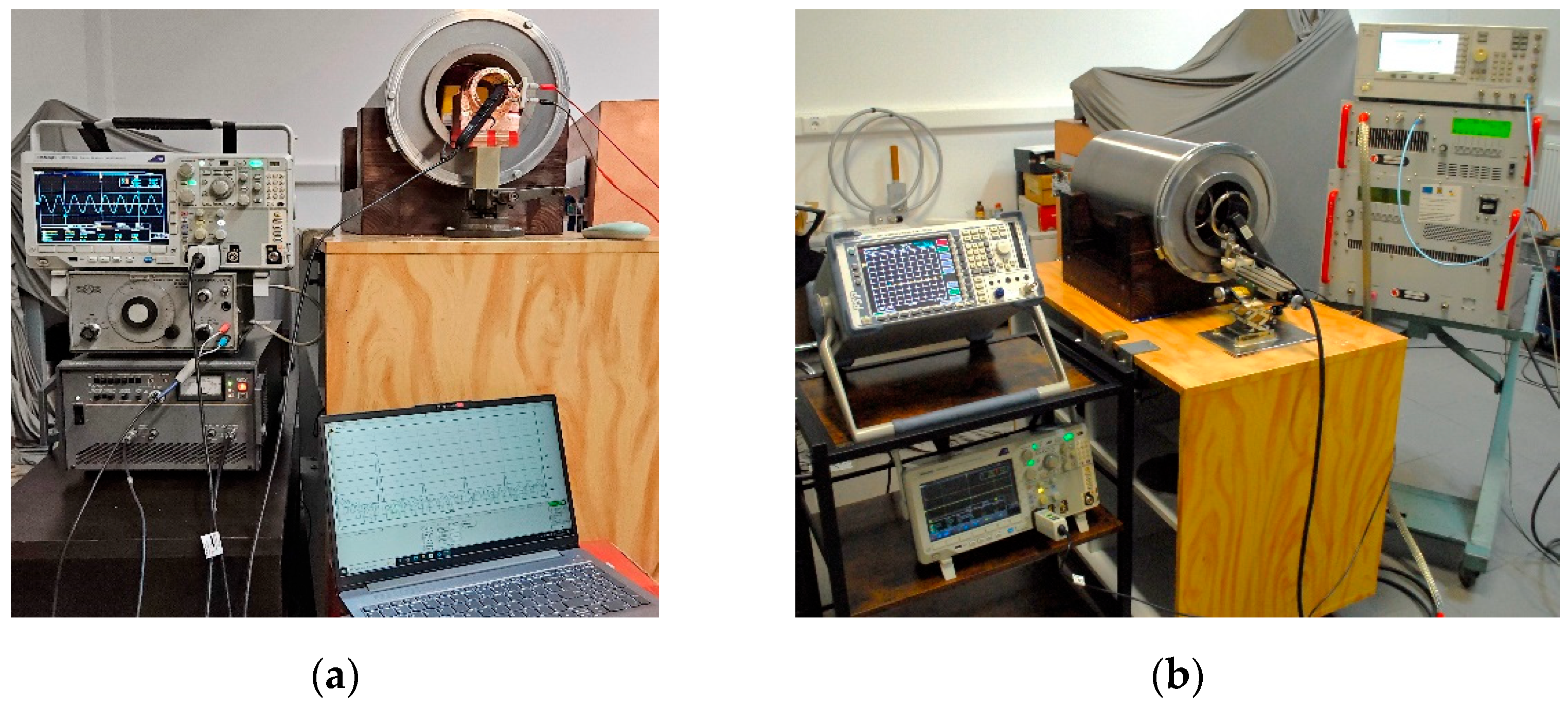
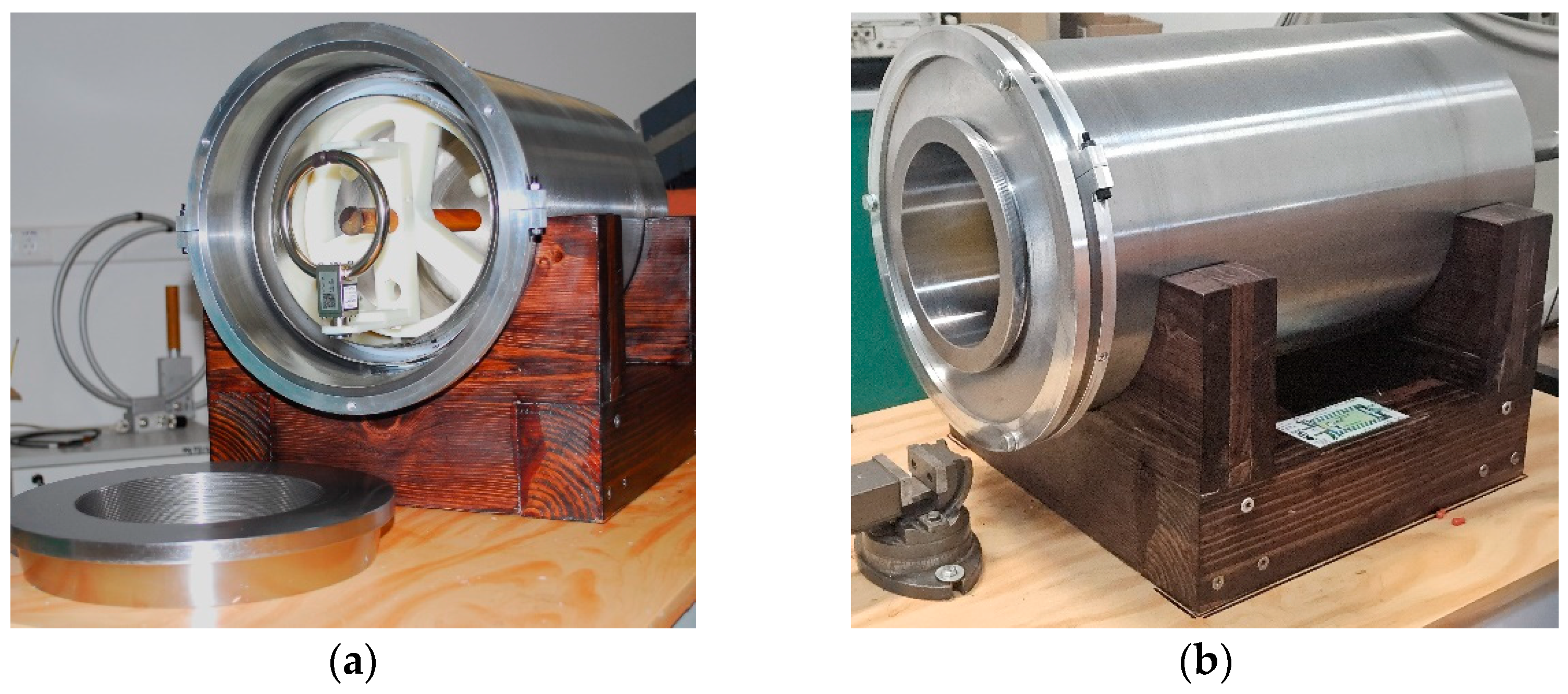
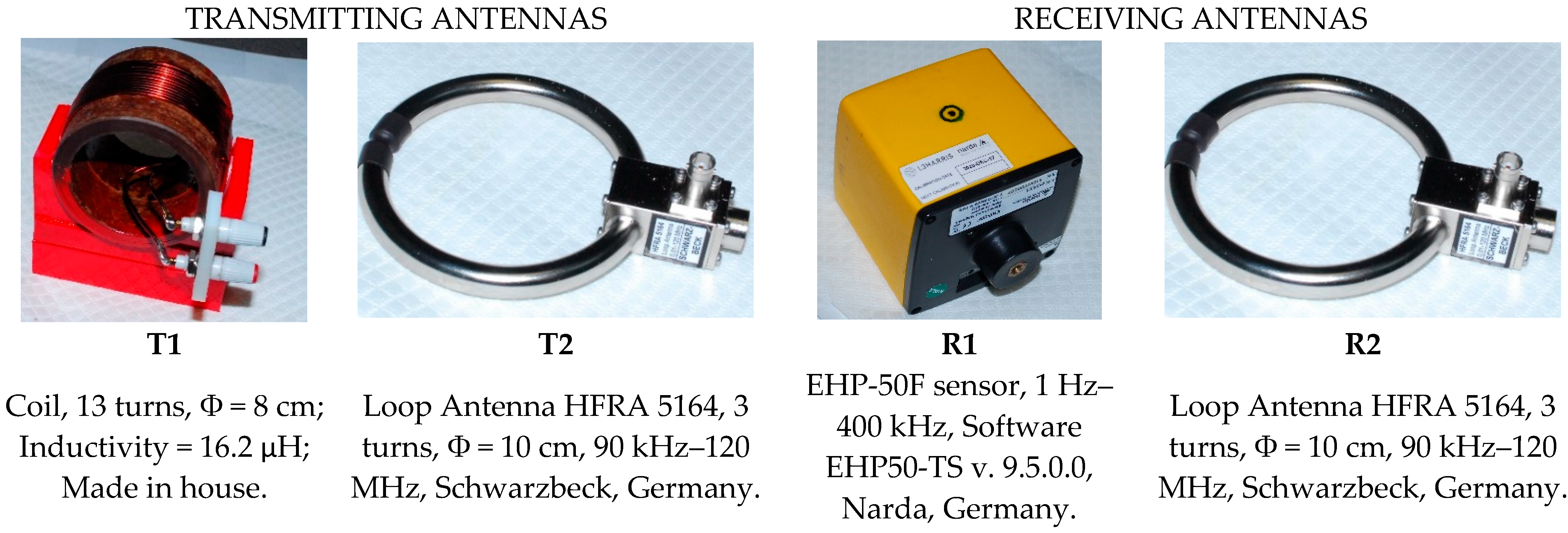
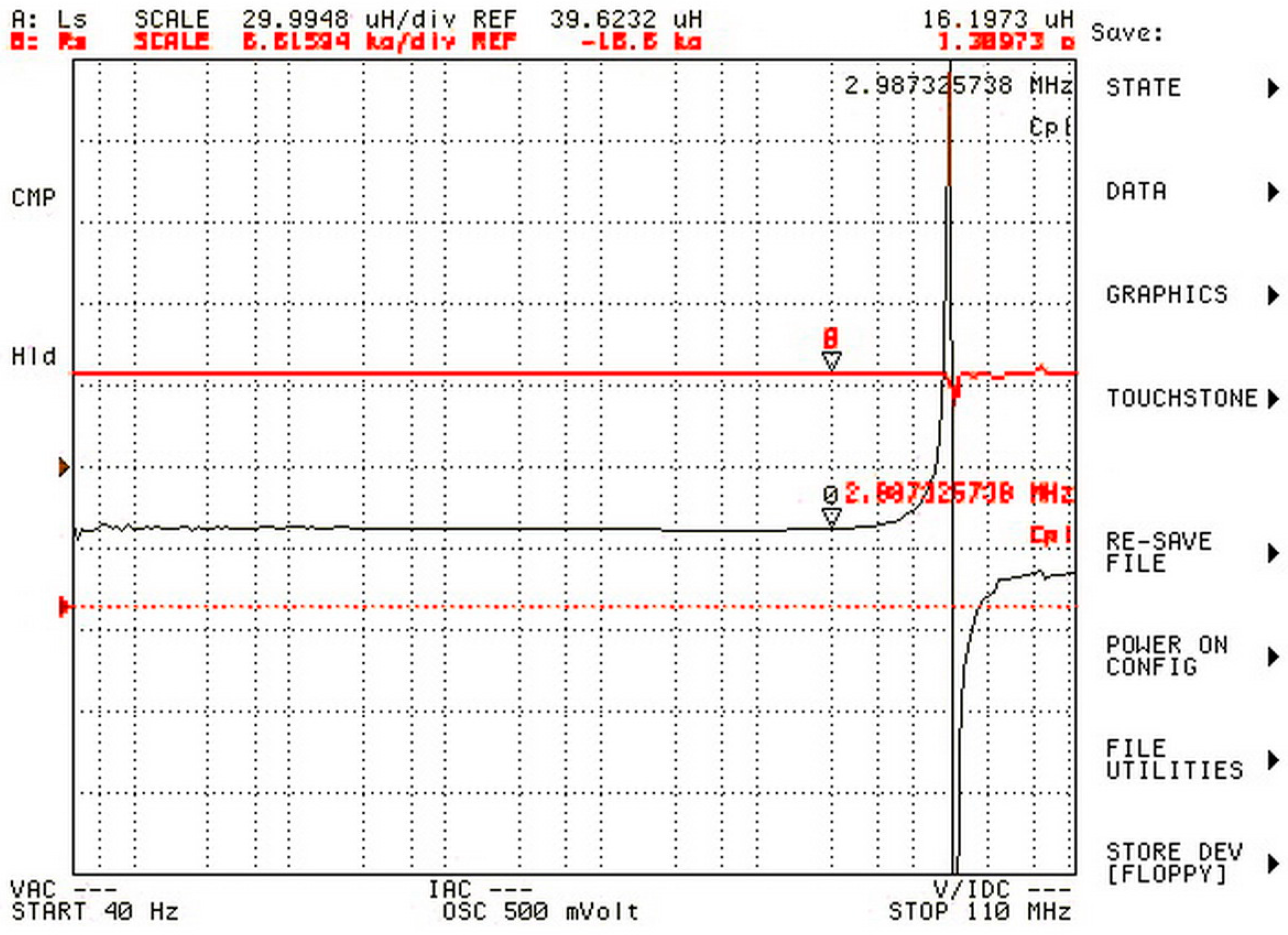




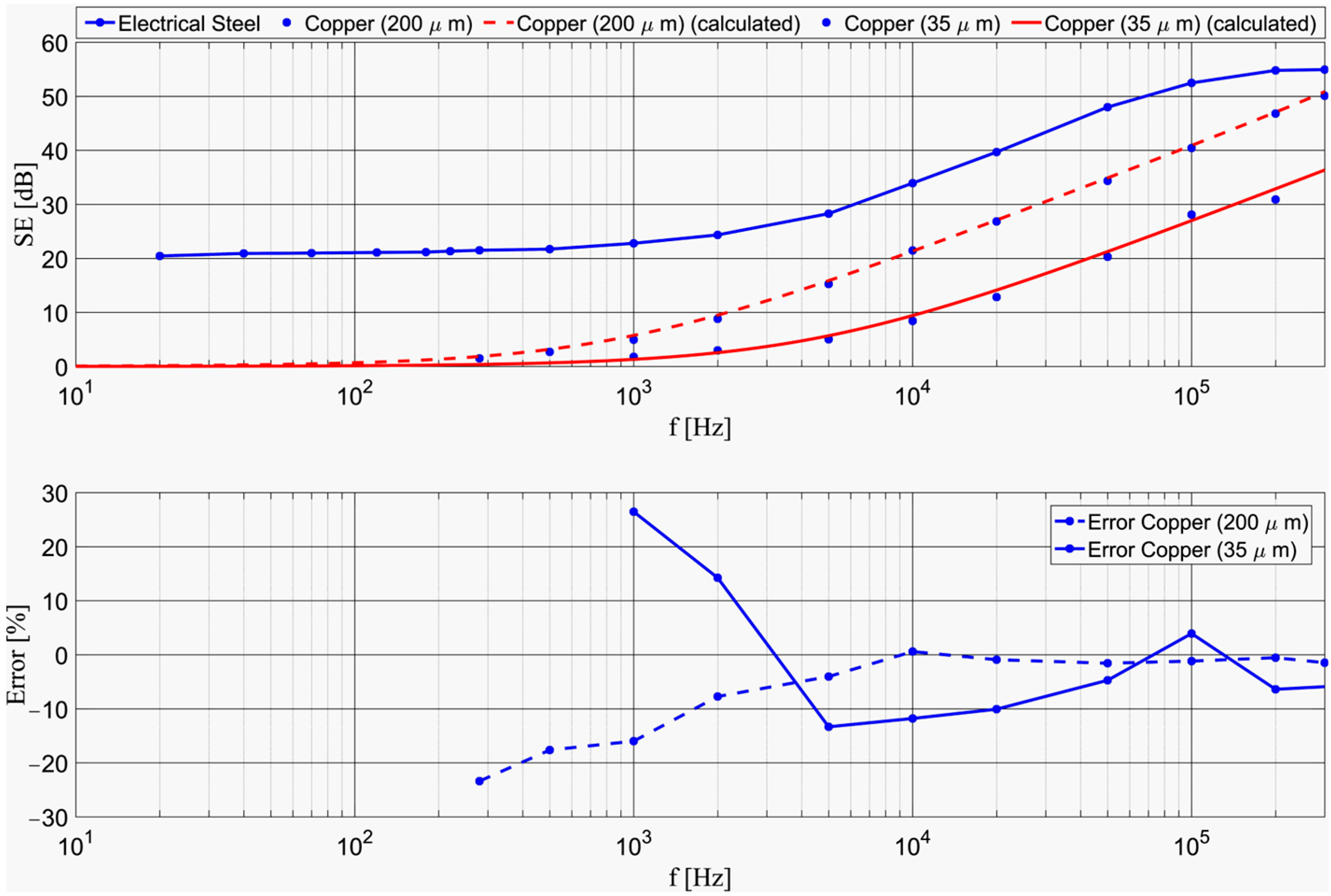
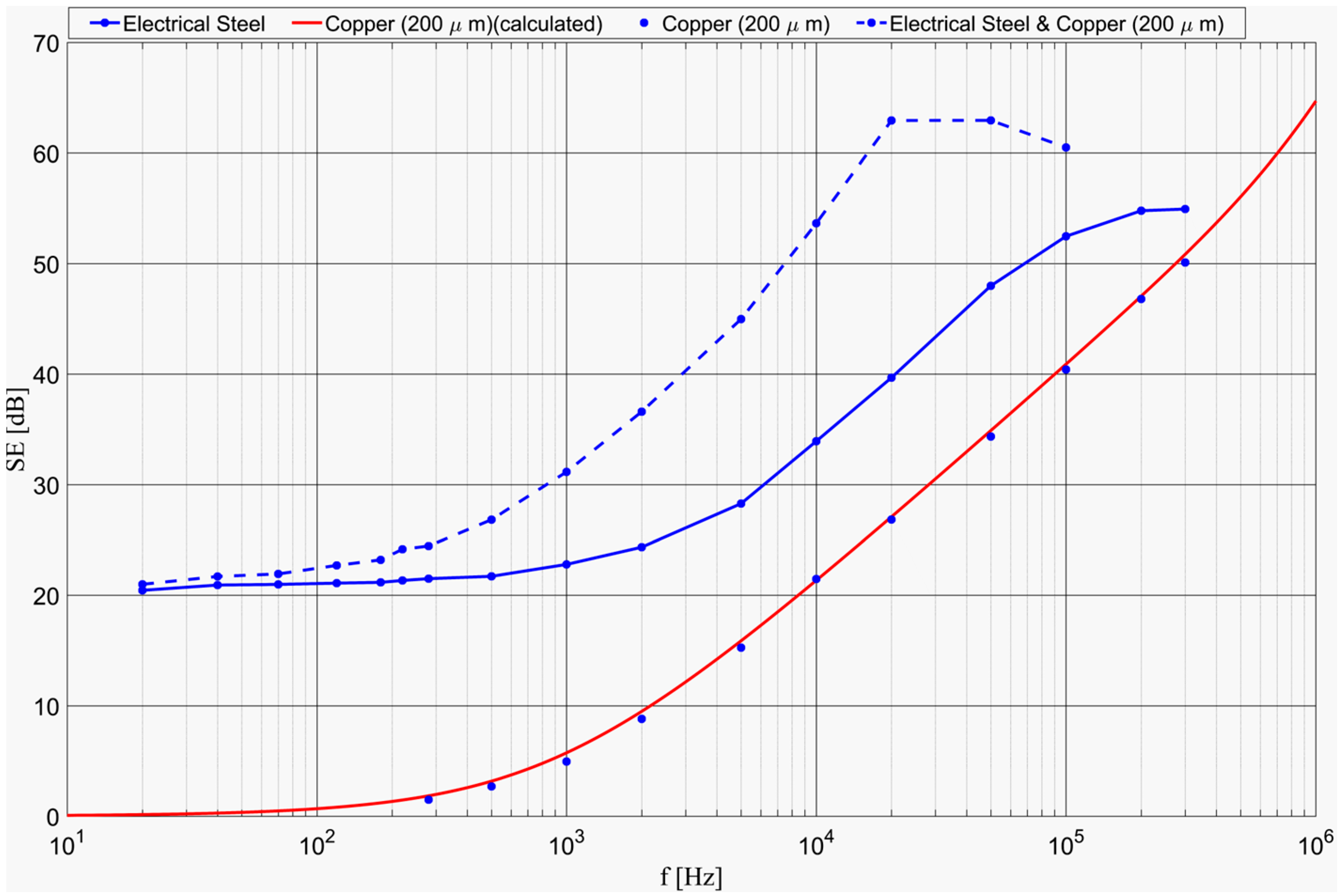
| Material | Manufacturer | Thickness [µm] | Electrical Conductivity [S/m] | Relative Magnetic Permeability (µr) |
|---|---|---|---|---|
| Copper 1 | Unknown | 35 | 3.92 × 107 | ≈1 |
| Copper 2 | Unknown | 200 | 3.46 × 107 | ≈1 |
| Aluminum | Unknown | 10 | 2.51 × 107 | ≈1 |
| Monel alloy 400 | Goodfelow, Huntingdon, UK | 25 | 1.07 × 106 | ≈1 |
| Toray carbon paper | Toray Industries, Neu-Isenburg, Germany | 500 | 9.92 × 103 | ≈1 |
| Graphite foil 1 | ProGraphite GmbH, Untergriesbach, Germany | 200 | 4.25 × 104 | ≈1 |
| Graphite foil 2 | 500 | 6.49 × 104 | ≈1 | |
| Graphite foil 3 | 1000 | 8.81 × 104 | ≈1 | |
| Electrical steel | Cogent Power Ltd., Newport, UK | 330 | ≈2 × 106 [78,79] | unknown |
| Instrument | Model | Specifications | Manufacturer |
|---|---|---|---|
| Oscilloscope | MDO 3102 | 1 GHz/dual channel | Tektonix, Beaverton, OR, USA |
| Current probe | TCP0030A | 5/30A, 120 MHz | Tektonix, Beaverton, OR, USA |
| Current probe | TCP0150 | 25/150A, 20 MHz | Tektonix, Beaverton, OR, USA |
| Low frequency signal generator | E 0501 | 1 Hz–1 MHz | IEMI, Bucharest, Romania |
| High speed bipolar amplifier | HAS 4014 | DC—1 MHz/200 VA | NF Corporation, Yokohama, Japan |
| Analog signal generator | E 8257D | 250 kHz–40 GHz | Agilent Technologies, Santa Clara, CA, USA |
| Power amplifier | SMX 50 | 9 kHz–1 GHz/50 W | Instruments for Industry, Ronkonkoma, NY, USA |
| Spectrum analyzer | FSP | 9 kHz–13.6 GHz | Rohde&Schwarz, Munich, Germany |
| Laptop | Lenovo | Intel CORE I7 | Lenovo |
| Precision impedance analyzer | 4294A | 40 Hz–110 MHz | Agilent Technologies, Santa Clara, CA, USA |
| Frequency | Signal level | SE | |||||||
|---|---|---|---|---|---|---|---|---|---|
| Enclosure Open | Enclosure Closed | Meas. 1 | Meas. 2 | Avg. | |||||
| Meas. 1 | Meas. 2 | Avg. 1 | Meas. 1 | Meas. 2 | Avg. | ||||
| [µT] | [µT] | [µT] | [µT] | [µT] | [µT] | [dB] | [dB] | [dB] | |
| 20 Hz | 10.85 | 10.8 | 10.82 | 0.0018 | 0.0017 | 0.00175 | 75.60 | 76.06 | 75.83 |
| 40 Hz | 11.02 | 11.05 | 11.03 | 0.0007 | 0.0006 | 0.00065 | 83.94 | 85.30 | 84.60 |
| 70 Hz | 10.32 | 10.37 | 10.34 | 0.0005 | 0.0006 | 0.00055 | 86.29 | 84.75 | 85.49 |
| 120 Hz | 10.56 | 10.62 | 10.59 | 0.0005 | >0.0005 | >0.0005 | 86.49 | 86.54 | 86.52 |
| 180 Hz | 10.25 | 10.15 | 10.20 | 0.0005 | >0.0005 | >0.0005 | 86.24 | 86.15 | 86.19 |
| 220 Hz | 10.53 | 10.48 | 10.50 | 0.0005 | >0.0005 | >0.0005 | 86.47 | 86.43 | 86.45 |
| 280 Hz | 10.27 | 10.27 | 10.27 | 0.0005 | >0.0005 | >0.0005 | 86.25 | 86.25 | 86.25 |
| 500 Hz | 10.15 | 10.34 | 10.24 | 0.0005 | >0.0005 | >0.0005 | 86.15 | 86.31 | 86.23 |
| 1 kHz | 9.43 | 9.58 | 9.50 | 0.0005 | >0.0005 | >0.0005 | 85.51 | 85.65 | 85.58 |
| 2 kHz | 8.20 | 8.36 | 8.28 | 0.0005 | >0.0005 | >0.0005 | 84.30 | 84.46 | 84.38 |
| 5 kHz | 6.44 | 6.67 | 6.55 | 0.0005 | >0.0005 | >0.0005 | 82.20 | 82.50 | 82.35 |
| 10 kHz | 5.58 | 5.64 | 5.61 | 0.0005 | >0.0005 | >0.0005 | 80.95 | 81.05 | 81.00 |
| 20 kHz | 4.89 | 4.95 | 4.92 | 0.0005 | >0.0005 | >0.0005 | 79.81 | 79.91 | 79.86 |
| 50 kHz | 4.62 | 4.73 | 4.67 | 0.0005 | >0.0005 | >0.0005 | 79.31 | 79.52 | 79.42 |
| [dBm] | [dBm] | [dBm] | [dBm] | [dBm] | [dBm] | [dB] | [dB] | [dB] | |
| 100 kHz | −39.90 | −39.80 | −39.85 | −118.80 | −120.00 | −119.40 | 78.90 | 80.20 | 79.55 |
| 200 kHz | −34.50 | −34.60 | −34.55 | −116.50 | −121.00 | −118.75 | 82.00 | 86.40 | 84.20 |
| 500 kHz | −27.60 | −27.60 | −27.60 | −115.40 | −118.70 | −117.05 | 87.80 | 91.10 | 89.45 |
| 1 MHz | −22.50 | −22.60 | −22.55 | −111.30 | −115.30 | −113.30 | 88.80 | 92.70 | 90.75 |
| 2 MHz | −16.00 | −15.80 | −15.90 | −113.60 | −114.00 | −113.80 | 97.60 | 98.20 | 97.90 |
| 5 MHz | −12.70 | −12.60 | −12.65 | −116.50 | −118.00 | −117.25 | 103.80 | 105.40 | 104.60 |
| 8 MHz | −18.00 | −17.80 | −17.90 | −122.30 | −125.00 | −123.65 | 104.30 | 107.20 | 105.75 |
| 10 MHz | −15.60 | −15.40 | −15.50 | −122.90 | −127.00 | −124.95 | 107.30 | 111.60 | 109.45 |
| 20 MHz | −20.10 | −20.20 | −20.15 | −129.90 | −134.80 | −132.35 | 109.80 | 114.60 | 112.20 |
| 30 MHz | −23.20 | −22.90 | −23.05 | −133.70 | −138.20 | −135.95 | 110.50 | 115.30 | 112.90 |
| 50 MHz | −29.70 | −28.20 | −28.95 | −130.00 | −130.50 | −130.25 | 100.30 | 102.30 | 101.30 |
| 60 MHz | −28.50 | −28.90 | −28.70 | −129.50 | −127.00 | −128.25 | 101.00 | 98.10 | 99.55 |
| 70 MHz | −29.90 | −30.00 | −29.95 | −129.40 | −131.50 | −130.45 | 99.50 | 101.50 | 100.50 |
| 80 MHz | −30.70 | −30.70 | −30.70 | −131.20 | −136.00 | −133.60 | 100.50 | 105.30 | 102.90 |
| Frequency | 1 kHz | 2 kHz | 5 kHz | 10 kHz | 20 kHz | 50 kHz | 100 kHz | 200 kHz | 500 kHz | 1 MHz |
| SE_H [dB] (measured) | 1.79 | 2.98 | 5.02 | 8.43 | 12.84 | 20.30 | 28.10 | 30.90 | 38.70 | 44.40 |
| SE_H [dB] (calculated) | 1.32 | 2.56 | 5.69 | 9.42 | 14.13 | 21.26 | 27.00 | 32.88 | 40.75 | 46.75 |
| Relative Error [%] | 26.46 | 14.23 | −13.34 | −11.80 | −10.08 | −4.73 | 3.92 | −6.40 | −5.31 | −5.30 |
| Frequency | 2 MHz | 5 MHz | 8 MHz | 10 MHz | 20 MHz | 30 MHz | 50 MHz | 60 MHz | 70 MHz | 80 MHz |
| SE_H [dB] (measured) | 50.30 | 58.30 | 62.70 | 65.00 | 70.70 | 79.10 | 84.60 | 88.30 | 92.6 | 95.7 |
| SE_H [dB] (calculated) | 52.78 | 60.87 | 65.21 | 67.37 | 74.96 | 80.39 | 88.62 | 91.97 | 94.99 | 97.76 |
| Error [%] | −4.93 | −4.41 | −4.00 | −3.64 | −6.02 | −1.63 | −4.75 | −4.16 | −2.58 | −2.15 |
| Frequency | 100 kHz | 200 kHz | 500 kHz | 1 MHz | 2 MHz | 5 MHz | 8 MHz | 10 MHz | 20 MHz | 30 MHz | 50 MHz | 60 MHz | 70 MHz | 80 MHz |
| SE_H [dB] (measured) | 13.53 | 19.80 | 29.10 | 32.00 | 37.20 | 44.00 | 47.70 | 49.40 | 54.50 | 56.80 | 64.10 | 63.50 | 66.20 | 67.10 |
| SE_H [dB] (calculated) | 13.49 | 18.75 | 26.25 | 32.12 | 38.06 | 45.97 | 50.05 | 51.98 | 58.00 | 61.53 | 65.99 | 67.60 | 68.96 | 70.15 |
| Error [%] | 0.32 | 5.28 | 9.79 | −0.37 | −2.31 | −4.49 | −4.92 | −5.22 | −6.42 | −8.32 | −2.95 | −6.45 | −4.17 | −4.54 |
| Frequency | 100 kHz | 200 kHz | 500 kHz | 1 MHz | 2 MHz | 5 MHz | 8 MHz | 10 MHz | 20 MHz | 30 MHz | 50 MHz | 60 MHz | 70 MHz | 80 MHz |
| SE_H [dB] (measured) | 1.66 | 3.60 | 8.80 | 14.80 | 19.60 | 27.28 | 31.33 | 33.17 | 37.26 | 40.17 | 46.60 | 46.80 | 49.70 | 50.50 |
| SE_H [dB] (calculated) | 2.50 | 4.65 | 9.28 | 13.97 | 19.28 | 26.81 | 30.78 | 32.68 | 38.63 | 42.13 | 46.55 | 48.13 | 49.47 | 50.63 |
| Error [%] | −50.69 | −29.11 | −5.50 | 5.63 | 1.63 | 1.73 | 1.75 | 1.47 | −3.68 | −4.88 | 0.11 | −2.84 | 0.47 | −0.25 |
| Frequency | 200 kHz | 500 kHz | 1 MHz | 2 MHz | 5 MHz | 8 MHz | 10 MHz | 20 MHz | 30 MHz | 50 MHz | 60 MHz | 70 MHz | 80 MHz |
| SE_H [dB] (measured) | 0.67 | 1.75 | 3.90 | 6.47 | 13.08 | 16.72 | 18.65 | 23.00 | 26.07 | 32.80 | 33.00 | 36.02 | 37.23 |
| SE_H [dB] (calculated) | 0.99 | 2.36 | 4.39 | 7.58 | 13.44 | 16.96 | 18.71 | 24.35 | 27.75 | 32.11 | 33.69 | 35.03 | 36.21 |
| Error [%] | −48.32 | −34.95 | −12.50 | −17.11 | −2.79 | −1.44 | −0.30 | −5.85 | −6.43 | 2.10 | −2.09 | 2.74 | 2.75 |
| Frequency | 100 kHz | 200 kHz | 500 kHz | 1 MHz | 2 MHz | 5 MHz | 8 MHz | 10 MHz | 20 MHz | 30 MHz | 50 MHz | 60 MHz | 70 MHz | 80 MHz | 100 MHz |
| SE_H [dB] (measured) | 0.65 | 1.35 | 3.20 | 6.25 | 10.99 | 18.16 | 22.35 | 23.93 | 28.48 | 31.10 | 37.55 | 37.50 | 40.45 | 41.34 | 42.44 |
| SE_H [dB] (calculated) | 0.84 | 1.63 | 3.82 | 6.74 | 10.81 | 17.47 | 21.21 | 23.03 | 28.83 | 32.28 | 36.67 | 38.25 | 39.59 | 40.75 | 42.71 |
| Error [%] | −28.54 | −21.07 | −19.30 | −7.81 | 1.62 | 3.83 | 5.10 | 3.74 | −1.23 | −3.80 | 2.34 | −2.00 | 2.13 | 1.42 | −0.64 |
| Frequency | 100 kHz | 200 kHz | 500 kHz | 1 MHz | 2 MHz | 5 MHz | 8 MHz | 10 MHz | 20 MHz | 30 MHz | 50 MHz | 60 MHz | 70 MHz | 80 MHz | 100 MHz |
| SE_H [dB] (measured) | 2.15 | 4.75 | 10.00 | 15.30 | 20.84 | 28.61 | 32.84 | 34.78 | 39.52 | 43.80 | 51.77 | 52.63 | 56.76 | 58.65 | 62.10 |
| SE_H [dB] (calculated) | 3.02 | 5.49 | 10.54 | 15.43 | 20.87 | 28.49 | 32.51 | 34.45 | 40.64 | 44.51 | 49.94 | 52.11 | 54.08 | 55.88 | 59.13 |
| Error [%] | −40.66 | −15.47 | −5.37 | −0.86 | −0.14 | 0.42 | 1.00 | 0.95 | −2.84 | −1.61 | 3.54 | 0.99 | 4.73 | 4.72 | 4.78 |
| Frequency | 100 kHz | 200 kHz | 500 kHz | 1 MHz | 2 MHz | 5 MHz | 8 MHz | 10 MHz | 20 MHz | 30 MHz | 50 MHz | 60 MHz | 70 MHz | 80 MHz | 100 MHz |
| SE_H [dB] (measured) | 4.80 | 9.23 | 16.34 | 22.04 | 28.32 | 36.67 | 41.99 | 44.66 | 53.88 | 60.67 | 74.45 | 77.70 | 83.80 | 87.60 | 94.10 |
| SE_H [dB] (calculated) | 6.99 | 11.13 | 17.83 | 23.44 | 29.31 | 37.61 | 42.42 | 44.96 | 54.44 | 61.34 | 71.72 | 75.96 | 79.81 | 83.34 | 89.71 |
| Error [%] | −45.72 | −20.56 | −9.15 | −6.35 | −3.51 | −2.56 | −1.02 | −0.67 | −1.04 | −1.11 | 3.67 | 2.24 | 4.77 | 4.86 | 4.66 |
| Frequency | 280 Hz | 500 Hz | 1 kHz | 2 kHz | 5 kHz | 10 kHz | 20 kHz | 50 kHz | 100 kHz | 200 kHz | 300 kHz |
| SE_H [dB] (measured) | 1.50 | 2.70 | 4.95 | 8.81 | 15.26 | 21.47 | 26.84 | 34.35 | 40.42 | 46.80 | 50.10 |
| SE_H [dB] (calculated) | 1.85 | 3.18 | 5.74 | 9.49 | 15.88 | 21.35 | 27.09 | 34.89 | 40.9 | 47.06 | 50.84 |
| Error [%] | −23.39 | −17.64 | −16 | −7.74 | −4.05 | 0.58 | −0.93 | −1.58 | −1.19 | −0.56 | −1.48 |
| Frequency | 20 Hz | 40 Hz | 70 Hz | 120 Hz | 180 Hz | 220 Hz | 280 Hz | 500 Hz | 1 kHz |
| SE_H [dB] (measured) | 20.45 | 20.92 | 20.98 | 21.1 | 21.17 | 21.34 | 21.5 | 21.71 | 22.79 |
| Frequency | 2 kHz | 5 kHz | 10 kHz | 20 kHz | 50 kHz | 100 kHz | 200 kHz | 300 kHz | |
| SE_H [dB] (measured) | 24.35 | 28.28 | 33.93 | 39.68 | 47.99 | 52.47 | 54.79 | 54.94 |
Disclaimer/Publisher’s Note: The statements, opinions and data contained in all publications are solely those of the individual author(s) and contributor(s) and not of MDPI and/or the editor(s). MDPI and/or the editor(s) disclaim responsibility for any injury to people or property resulting from any ideas, methods, instructions or products referred to in the content. |
© 2025 by the authors. Licensee MDPI, Basel, Switzerland. This article is an open access article distributed under the terms and conditions of the Creative Commons Attribution (CC BY) license (https://creativecommons.org/licenses/by/4.0/).
Share and Cite
Bădic, M.; Morari, C.; Dumitru, C. Near-Field Magnetic Shielding in the Frequency Range from 20 Hz to 100 MHz. Appl. Sci. 2025, 15, 12226. https://doi.org/10.3390/app152212226
Bădic M, Morari C, Dumitru C. Near-Field Magnetic Shielding in the Frequency Range from 20 Hz to 100 MHz. Applied Sciences. 2025; 15(22):12226. https://doi.org/10.3390/app152212226
Chicago/Turabian StyleBădic, Mihai, Cristian Morari, and Constantin Dumitru. 2025. "Near-Field Magnetic Shielding in the Frequency Range from 20 Hz to 100 MHz" Applied Sciences 15, no. 22: 12226. https://doi.org/10.3390/app152212226
APA StyleBădic, M., Morari, C., & Dumitru, C. (2025). Near-Field Magnetic Shielding in the Frequency Range from 20 Hz to 100 MHz. Applied Sciences, 15(22), 12226. https://doi.org/10.3390/app152212226






